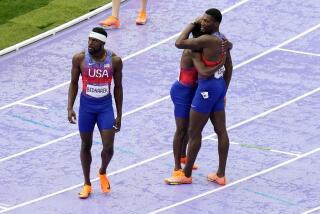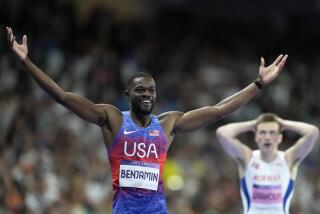U.S. Prospects in Track and Field Are Bright for Seoul Olympics
- Share via
NEW YORK — The Star Spangled Banner is likely to be heard as often as the Soviet and East German national anthems when Olympic officials conduct the medal ceremonies for track and field events in Seoul, South Korea.
That’s a modest assessment by old-time standards but consider this:
The United States team was outclassed by East Europeans in both 1972 and 1976--the last Olympics staged before boycotts prevented the world’s best from competing against each other. After Americans claimed 15 out of a possible 36 gold medals at Mexico City in 1968, they won only six in each of the ’72 and ’76 Games, all by the men.
But if the U.S. Olympic Trials at Indianapolis July 15-23 are an indication of how the Americans will perform at Seoul, a rebound to the glory days of 1968 is in the offing. An early forecast sees the United States with a chance of winning anywhere from 14 to 17 gold medals from 42 events.
The men have shown consistency in the Olympics, winning their share of championships. They’ll do it again this year.
The women, however, have been overshadowed by the East Germans and the Soviets. Over the last 20 years, East Bloc women have been able to run faster, jump higher and throw farther than the Americans. But the Seoul Olympics figure to be different.
American women not only have cut the gap, but seem to have reached a new level in the sprints.
Florence Griffith-Joyner showed at the Olympic Trials she has developed into the world’s next great women’s sprinter. In her first season concentrating on the 100, she has obliterated the world record. She ran a 10.49 to slice 27 one-hundredths of a second off Evelyn Ashford’s previous mark of 10.76.
In the 200, her best event, Griffith-Joyner posted a 21.77 to set an American record and challenge the world standard of 21.71.
Those times came in Indianapolis on one of the fastest tracks in the world, so don’t expect to see those times in Seoul. But no matter where they were run, they had to have sent a chilling message to the East German sprinters.
“We have destroyed their minds,” said Gwen Torrence, who finished third in Griffith-Joyner’s world-record race. “I’ve had dreams about that 10.49.”
That psychological edge may be worth a couple of medals in Seoul.
The United States also will benefit from great depth as well as great athletes. Both men’s Coach Stan Huntsman and women’s Coach Terry Crawford are thrilled with their teams.
“I think it’s the strongest U.S. team ever, the best collection of American athletes we’ve ever had,” Huntsman said. “This (men’s) team might beat the 1968 team in a dual meet.”
Said Crawford of her squad: “If we can go in in condition, compete at the level we did in Indianapolis, we can come home with more Olympic medals than we’ve ever had at an international meet with all the world powers present. I can’t tell you how content I am with the athletes on this team.”
Both teams will rely on their sprinters to win most of their medals. Neither squad is particularly strong in long distance running or the throwing events, so any medals from those disciplines would be bonuses.
The sprints and hurdles, however, will be exciting. The men could conceivably sweep those events.
Carl Lewis spearheads the men’s team and will have an opportunity to repeat his four-gold medal performance of 1984. Edwin Moses will return, favored to win his third Olympic title in the 400-meter hurdles, and Roger Kingdom is a good bet to retain his 110-meter hurdles title.
Among the women, Griffith-Joyner will likely medal in three events, Jackie Joyner-Kersee is the prohibitive favorite in the heptathlon and has an excellent chance to win the long jump. Mary Decker Slaney is entered in two events, the 1,500 and 3,000 meters. If she stays healthy and avoids falls, she’ll be favored in both.
Lewis ran a wind-aided 9.78 in the 100 at the Olympic Trials, the fastest time ever under any conditions. Ben Johnson, who set a world record 9.83 while beating Lewis at the 1987 World Championships, has been injured this year. Unless Johnson is healthy, Lewis should repeat in the 100.
Dennis Mitchell of Florida and Calvin Smith, who shares the American record with Lewis, also are strong medal candidates in the 100.
If he competes in the 200, Lewis will be favored. The second round of the 200 and the long jump final are scheduled an hour apart, and unless the timetable is changed, Lewis may forego the sprint.
Whether Lewis runs or not, an American should win that event. Look for Lewis or Joe DeLoach, who edged Lewis at the Trials.
Butch Reynolds and UCLA teammates Danny Everett and Steve Lewis comprise quite possibly the most explosive 400 meters team in history. Reynolds and Everett both clocked less than 44 seconds at the Trials, and 19-year-old Steve Lewis posted a 44.11 to set a world junior record.
Reynolds could head a possible American sweep, but dangerous rivals are Thomas Schoenlebe of East Germany and Innocent Egbunike of Nigeria, who finished ahead of Reynolds at the last World Championships.
U.S. men have no gold prospects in any events past the 400, but will most likely win both hurdles races and both relays.
Moses appears unbeatable as he approaches his 33rd birthday and Andre Phillips and Kevin Young of UCLA give the United States a shot for 1-2-3 in the 400 hurdles. Harald Schmid of West Germany is the major threat to spoil an American sweep.
Despite the absence of Greg Foster, the Americans could claim three medals in the 110 hurdles. Kingdom looks unstoppable and teammates Tonie Campbell and Arthur Blake are excellent bets for medals. Jon Ridgeon and Colin Jackson of Britain will also be tough.
The 4 x 100 and 4 x 400 relays belong to the Americans and world records could fall in both.
Carl Lewis should be a lock in the long jump, but it’s doubtful he’ll break Bob Beamon’s world record of 29 feet, 2 1/2 inches in Seoul. Larry Myricks should join Lewis in the top three.
If Willie Banks gets hot, he could steal a medal in the triple jump. He’ll have to be at his best, however, to beat Bulgaria’s Khristo Markov.
Most of the women’s medal prospects lie in the same events as the men’s. Griffith-Joyner looks solid in the 100 and 200, but she’ll receive stiff challenges from an East German brigade that includes Silke Gladisch and Heike Drechsler.
Gladisch won both sprints at the World Championships and Drechsler took second in the 100. Torrence is a medal threat in both races and Ashford has a shot in the 100.
If Valerie Brisco can work herself into shape, she has a chance to retain her title in the women’s 400.
Slaney gives the United States a dimension it has lacked the last three years. Since returning from giving birth and surgery on her Achilles tendon, Slaney has shown good form.
Her infamous collision with Zola Budd at the ’84 Games will forever assure Slaney a place in Olympic history, but she could make up for that in Seoul.
She’ll get an opportunity to claim the gold medal denied her in the 3,000 and then move on to the 1,500. Her primary opposition will come from Tatyana Samolenko of the Soviet Union, the world champion in both events.
“I plan to run the 3,000 as if it’s the only event,” Slaney said. “The 1,500 won’t exist in my mind until the 3,000 is over. Los Angeles in my mind doesn’t exist.”
Joyner-Kersee is another American woman with gold medal aspirations in two events. Barring catastrophe, she’ll breeze to victory in the heptathlon and will shoot for her second world record of the year.
Joyner-Kersee will receive strong competition, however, in the long jump from Drechsler and world record-holder Galina Chistyakova of the Soviet Union.
Drechsler is the most consistent of the three, but Joyner-Kersee has shown dramatic improvement over the last two years. Chistyakova, whose 24-8 leap in June broke the world mark of 24-5 1/2 shared by Drechsler and Joyner-Kersee, will need a big day to win.
The American women could win both relays, but they’ll have a better shot in the 4 x 100.
More to Read
Go beyond the scoreboard
Get the latest on L.A.'s teams in the daily Sports Report newsletter.
You may occasionally receive promotional content from the Los Angeles Times.






